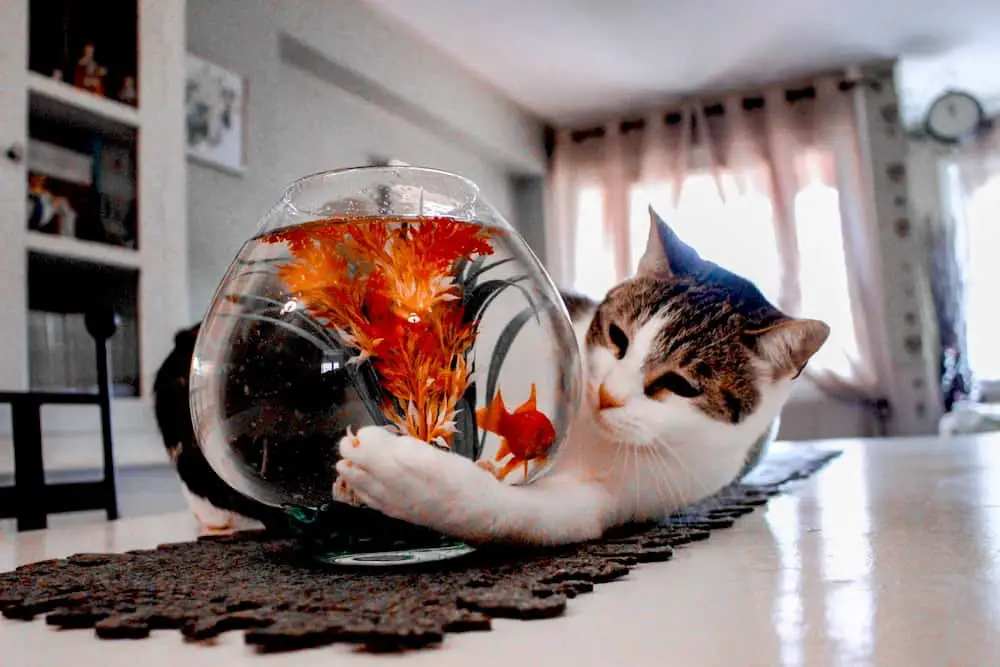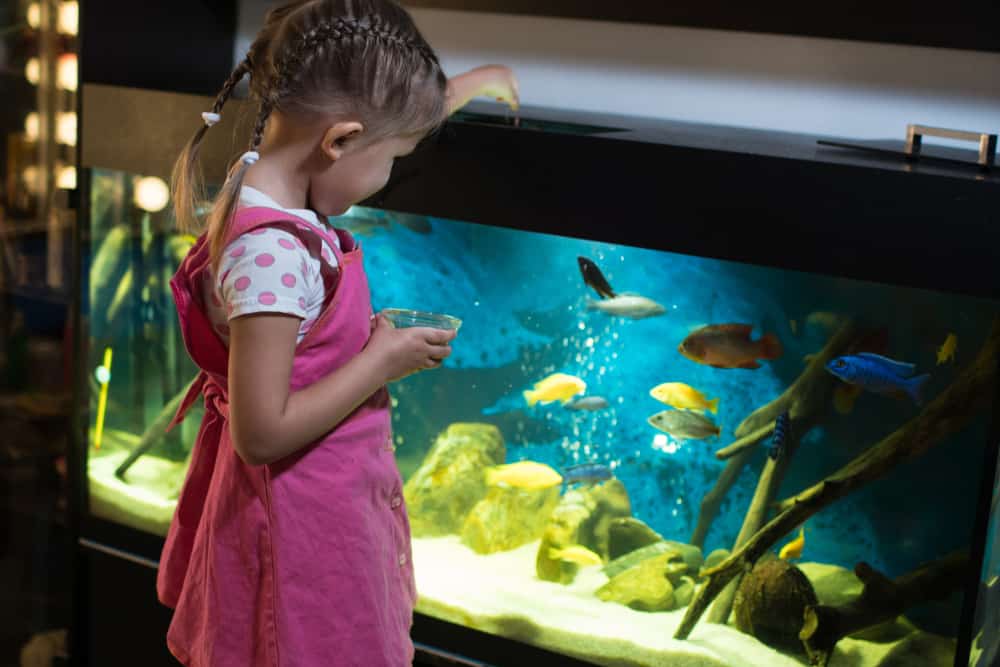Fishbowls are a popular choice for pet owners because they’re small, cheap to assemble, require minimal maintenance, and are a great aesthetic piece to have around the house. Although fishbowls might be easy to care for, they might not be the best environment for your fish.
Fishbowls can be one of the most cruel environments that you could force a pet fish to live in. Most experts, pet owners, and fanatics agree that it is inhumane for a fish to live in a fishbowl because it doesn’t provide enough living space or oxygen in the water, and the lack of filtration leaves your fish at significant risk of disease.
Several factors render fishbowls a potentially cruel environment for your fish, and we’ll discuss all of them in this article. Not only will we detail why they aren’t the optimal choice for your pet, but we’ll also help you find the right enclosure so your fish can live a long and fulfilling life.
Why Are Fishbowls Cruel?
Although there is always debate about the best ways to care for domestic animals, experts and fish fans unanimously agree that fishbowls are cruel.
It has been frequently proven that these environments can’t supply fish with their most basic needs and can severely affect them physically and mentally. There are also several safety risks connected to fishbowls that could result in an accidental fish fatality.
If you are considering placing your fish in a an old-school round bowl, please read these reasons on why this type of enclosure is inhumane first.
A Fishbowl Increases Your Fish’s Risk of Suffocation
The concept of fish suffocation might surprise some people considering its associated with oxygen, and fish are aquatic animals.
The fact of the matter is that aquatic animals like fish use their gills to extract the oxygen necessary to breathe. If they cannot obtain sufficient oxygen in the water, they will go to its surface to get more. So, what does this have to do with fishbowls?
One of the most significant dangers of fishbowls is that they could actually cause your fish to suffocate from lack of oxygen. As opposed to fish tanks with uniform measurements, the top of a fishbowl is much narrower than its widest point in the middle of the bowl.
Because of this, there is not sufficient water surface for efficient gas exchange, especially if the owner has completely filled the bowl. This low surface-to-air ratio means there is less oxygen in the water for your fish to breathe, which could cause them to suffocate.
Although we don’t condone the use of fishbowls, if you are going to use one, perhaps to hold your fish while you clean their normal tank enclosure, only fill the bowl halfway to ensure that water’s oxygen can diffuse as quickly as your fish's breathing is consuming it.
The Bowl’s Shape and Design is a Safety Risk to Your Fish
You want to believe that your fish is nice and safe in its cute little fishbowl, but in reality, you’ve actually increased your fish’s chances of unintentionally injuring itself.
The most obvious source of potential danger is the open-top on fishbowls. Most fish tanks have lids for two reasons:
Fish will often jump out of their tank if they deem it an unsuitable living environment for reasons such as lack of hiding places, low oxygen levels, and improper pH balance. All of which are extremely common in fishbowls, and so, it is not unlikely your fish will try to jump out.
Not only is the open-top a risk for your potentially suicidal fish, but it also leaves easy access for any house pets to mess with your fish and allows contaminants and foreign objects to fall into the bowl.
The last factor to consider is that the shape of your fishbowl actually distorts your fish’s vision because of the spherical design. Therefore, objects appear blurred, larger, or further than they actually are. As a result, your fish can become stressed from its constantly distorted vision and could even injure itself swimming into the glass.
Lack of Filtration Can Cause Disease
The newest fish owners might assume that as long as their fish is in clean water, it’s going to live a happy life. While it’s true that you don’t want to see your fish’s waste floating around in their enclosure, sometimes the most dangerous and life-threatening things in your fishbowl are those you can’t even see.
Fishbowls are not stable environments, and so they need filtration to help regulate and clean the water of both physical and chemical contaminants. The essential role of a filtration device is removing a fish’s waste, so it isn’t swimming in its own filth all the time.
If you own a fishbowl and think that you regularly remove your fish’s waste, so this isn’t an issue, you’re wrong. It’s not just the physical waste that can harm your fish, but the chemical left behind when it decomposes as well.
You might be able to remove the physical waste, but without a filtration device, the toxic chemicals left behind from its gradual decomposition will lead to serious, life-threatening illnesses for your fish. The only way to remove them without these helpful devices is to change the water completely and clean the bowl.
Funnily enough, this is an issue that doesn’t just affect fish that live in bowls, but also those that are placed in aquariums. That water isn’t always as clean as they say it is. Find out more here: Are Aquariums Cruel to Animals?
Insufficient Space for the Fish to Thrive
Many owners will purchase fishbowls because they are small and cheap. Although this might be nice for your wallet, it’s detrimental to the well-being of your fish.
Just like any pet, your fish needs room to swim and explore its environment.
Not only are fishbowls so small your fish can hardly swim back and forth, but they’re also too small to fill them with enrichment elements like fake or real plants, toys, and structures, or even companions.
That’s right. Many commonly owned fish, like the goldfish, are actually social creatures and will mentally and emotionally deteriorate without a companion. In fact, it is illegal for pet owners to have a single goldfish in Switzerland because it is essential to their well-being to have a companion.
By placing your fish in a fishbowl, you are not only inhibiting its mobility, but you are also severely diminishing its mental, emotional, and consequentially physical health by keeping it in such a confined space.
What Enclosure is Best for Fish?
If a fishbowl is an insufficient environment for your fish, then you might be wondering what the better option is. Well, that ultimately depends on what kind of fish or fishes you have.
The short answer to the question is that your pet fish should always be kept in a sufficiently sized tank or aquarium, but of course, the tricky part here is knowing which one to buy.
A great place to start is choosing the enclosure that is going to provide your fish with ample space to live and thrive. PETA recommends that there are at least 24 square inches of water for every 1 inch of fish. If it helps, this rule has also be restated as 1 gallon of water per inch of fish since tanks are typically labeled in gallons.
It’s important to research the type of fish you want so you know defining factors such as:
You want to make sure the tank you have, or will have, is suitable for the fish pet of your dreams. Thoroughly researching their needs will help you make an educated decision on what you need to do to accommodate them.
Remember that your fish aren’t the only things you should have in the tank. You’ll want to add enrichment elements as well, like proper lighting, toys, and even co-habitable species to promote stimulation and help them thrive.
Another great example of a safer and healthier aquatic environment is a pond. Something like a Koi pond is not innately cruel if you know how to care for it properly. Here’s what you need know about raising Koi fish humanely: Are Koi Ponds Cruel?
Final Thoughts
Fishbowls are so cruel that they have even been banned in locations such as Rome, Monza, and various Swiss and Mexican cities. They are unsuitable enclosures for fish as they lack sufficient living space and pose a significant risk to the fish’s mental and physical health due to their lack of filtrations, reduced oxygen levels, and poor design.
Fishbowls might be small and cheap, but they are no easier to maintain than a filtered fish tank, and they will severely reduce your fish’s life expectancy. If you want your scaly pet to live and thrive for years to come, steer clear of the bowl.


